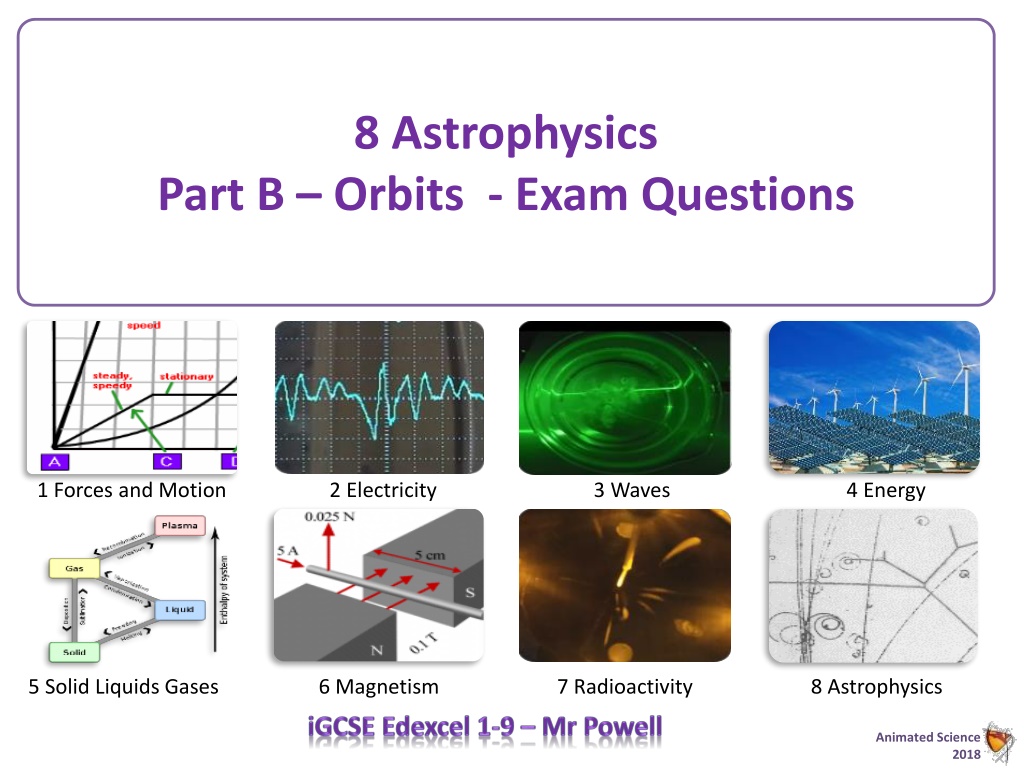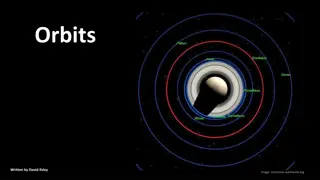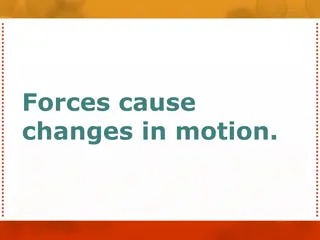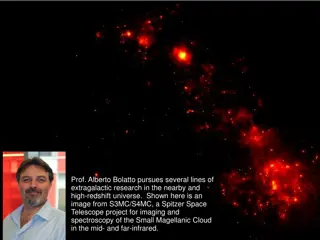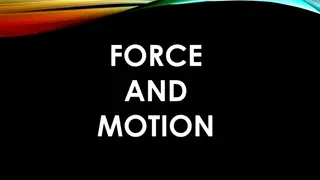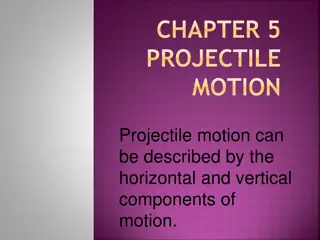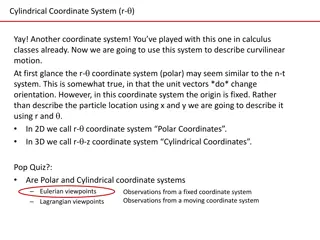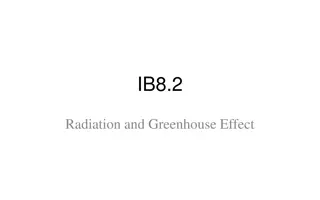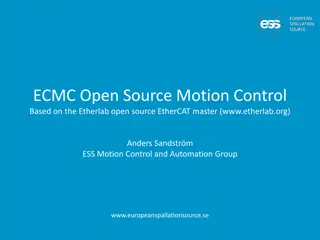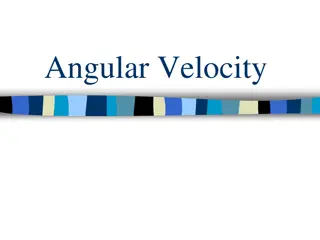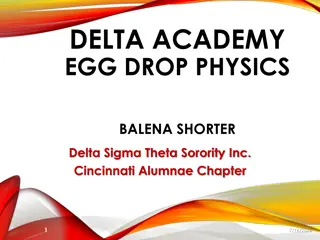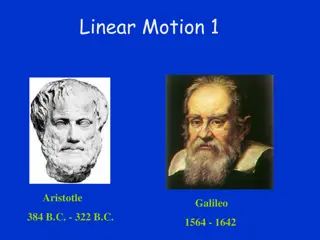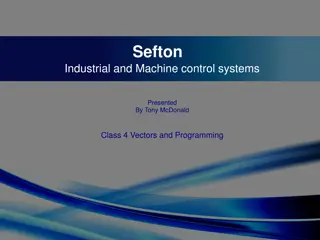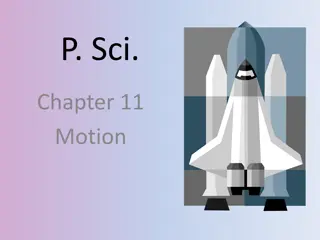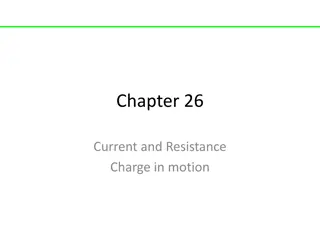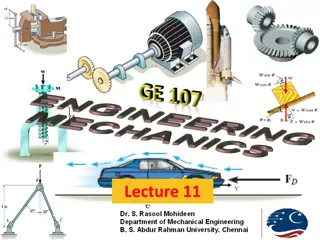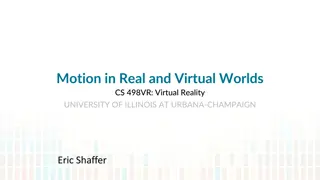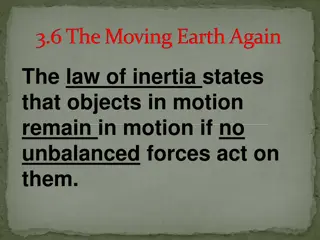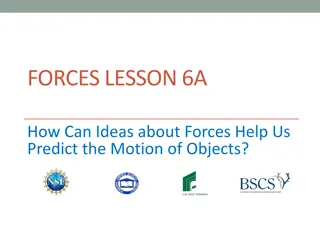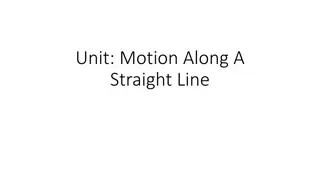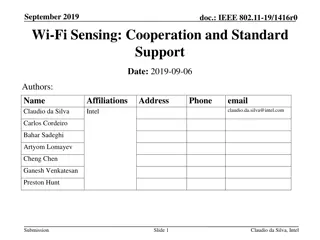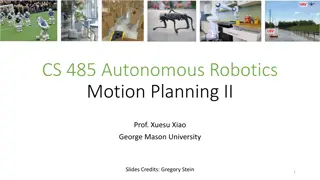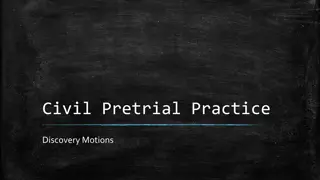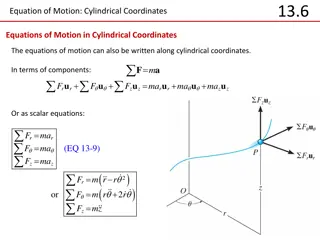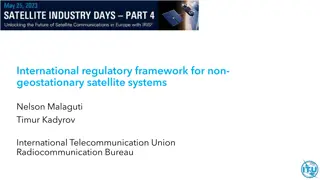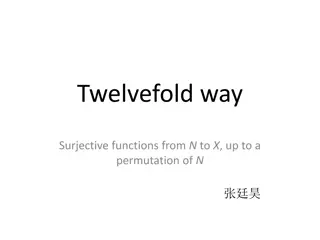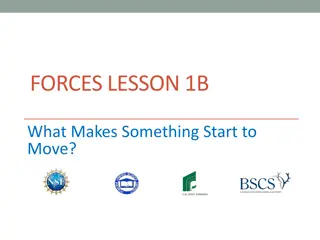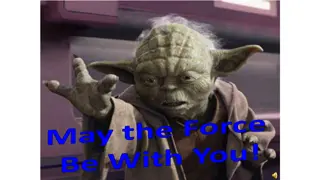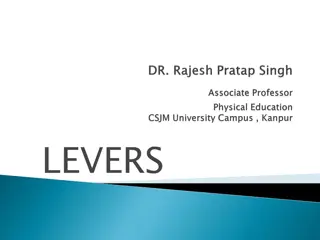Understanding Orbits and Motion in Astrophysics
Explore the concept of orbits and motion in astrophysics, covering gravitational forces, planetary orbits, orbital speeds, and celestial phenomena like lunar eclipses. Delve into how objects move in space, the relationships between orbital speed, radius, and time period, and the dynamics of celestial bodies in the universe.
Download Presentation

Please find below an Image/Link to download the presentation.
The content on the website is provided AS IS for your information and personal use only. It may not be sold, licensed, or shared on other websites without obtaining consent from the author. Download presentation by click this link. If you encounter any issues during the download, it is possible that the publisher has removed the file from their server.
E N D
Presentation Transcript
8 Astrophysics Part B Orbits - Exam Questions 1 Forces and Motion 2 Electricity 3 Waves 4 Energy 5 Solid Liquids Gases 6 Magnetism 7 Radioactivity 8 Astrophysics Animated Science 2018
8B Motion in the Universe p377 8.2 know that: the universe is a large collection of billions of galaxies a galaxy is a large collection of billions of stars our solar system is in the Milky Way galaxy. 8.3 understand why gravitational field strength, g, and know that it is different on other planets and the Moon from that on the Earth 8.4 explain that gravitational force: causes moons to orbit planets causes the planets to orbit the Sun causes artificial satellites to orbit the Earth causes comets to orbit the Sun 8.5 describe the differences in the orbits of comets, moons and planets 8.6 use the relationship between orbital speed, orbital radius and timeperiod: orbital speed = (2 orbital radius)/time period v = (2 r)/T Animated Science 2018
Lesson 2 Orbits of Planets Speeds Orbital period T (years) 0.25 0.61 1.00 1.88 11.86 29.45 84.01 164.80 Distance travels 2 r (AU) 2.45 4.52 6.28 9.55 32.67 59.82 120.64 189.12 Orbital speed of planet 2 r /T (AU per year) 9.80 7.42 6.28 5.08 2.75 2.03 1.44 1.15 Distance to Sun (r) (AU) Planet Mercury Venus Earth Mars Jupiter Saturn Uranus Neptune 0.39 0.72 1.00 1.52 5.20 9.52 19.20 30.10 12.00 10.00 Orbital Speed AU/ year 8.00 6.00 4.00 2.00 0.00 0.00 20.00 40.00 60.00 80.00 100.00 120.00 140.00 160.00 180.00 200.00 Animated Science Distance the planet Travels 2018
Relationship between orbital speed, orbital radius and time period For GCSE Physics we say that each solar body will follow an orbit in a time according to a simple formula which relates radius of orbit, and velocity of body. ? =2?? v =2?? ? ? distance / time = speed From this equation we can see that the a larger orbit will mean a longer time period. This means that the velocity of orbit will be lower for planets further away. (see graph for examples). This is a simple version of a more complex (more accurate equation) and works pretty well for the moon but as you get further away it is not so good. Animated Science 2018
Using the relationship between orbital speed, orbital radius and time period Worked Example..... Earth 2 r = T Radius of orbit = 149.6 million km Time for Orbit = 365.25 days v r= 149.6 x 106km r = 149.6 x 109m r = 1.496 x 1011m v =2?? ? T = 365.25 * 24 * 60 * 60 T = 31557600s v = 2 r/T v = (2 * 1.496 x 1011m) / 31557600s v = 29,785.67ms-1 v = 29,786 ms-1 v= 29,790 ms-1 (4 sig figs) v= 29,800 ms-1 (3 sig figs) Animated Science 2018
Lunar Eclipse A lunar eclipse occurs when the Moon passes directly behind the Earth into its umbra (shadow). This can occur only when the sun, Earth, and moon are aligned exactly, or very closely so, with the Earth in the middle. Hence, a lunar eclipse can occur only on the night of a full moon. A total lunar eclipse has the direct sunlight completely blocked by the earth's shadow. The only light seen is refracted through the earth's shadow. This light looks red for the same reason that the sunset looks red, due to scattering of the more blue light. Because of its reddish colour (blood moon) Animated Science 2018
Solar Eclipse As seen from the Earth, a solar eclipse is a type of eclipse that occurs when the Moon passes between the Sun and Earth, and the Moon fully or partially blocks ("occults") the Sun. This can happen only at new moon when the Sun and the Moon are in conjunction as seen from Earth. In a total eclipse, the disk of the Sun is fully obscured by the Moon. In partial and annular eclipses, only part of the Sun is obscured. If the Moon were in a perfectly circular orbit, a little closer to the Earth, and in the same orbital plane, there would be total solar eclipses every month. However, the Moon's orbit is inclined (tilted) at more than 5 degrees to the Earth's orbit around the Sun (see ecliptic), so its shadow at new moon usually misses Earth. Total solar eclipses are rare at any particular location because totality exists only along a narrow path on the Earth's surface traced by the Moon's shadow or umbra. Animated Science 2018
Lesson 8.2 Orbits of planets, moons and artificial satellites Books. 1 The force of gravity. 2 The further the distance, the longer it takes to orbit the Sun. 3 The distance the planet has to travel for a complete orbit around the Sun is larger the further away it is from the Sun so it takes longer to make a complete orbit. Another reason is that the planets further out travel slower as the Sun s gravity is weaker. 4 The field of gravity or forces created by gravity. 5 a and b . 6 Velocity has a magnitude and a direction. Since the direction is changing the velocity is changing. 7 The radius of its orbit and the speed it is going. 8 The faster the satellite is travelling, the closer it is to the surface of the Earth. Animated Science 2018
Exam Practice Question 2019 P2 gravitational (force) time period of moon is shorter; idea that it travels a shorter distance / orbital radius is smaller; Animated Science 2018
Exam Practice Question 2015 P2 gravitational (force) Any two of - MP1 Idea that orbits cross/meet/ intersect; at the same place orbits overlap MP2 Idea that comet and planet can be (at the same place) at the same time; MP3 Idea that orbit time periods are different; idea of orbiting at different speeds Animated Science 2018
Exam Practice Question 2016 P1 June Q6 A comet passes close to the Earth. An astronomer observes the position of the comet and the Earth on the same day each week for several weeks. The diagram shows her observations for weeks 1 to 11 (i) Complete the path for the comet between week 5 and week 7. (1) (ii) Mark an X on the diagram to show the position of the Sun. (1) (iii) Suggest why the astronomer did not observe the comet during week 6. (1) Parabolic orbit completed / X inside the grey shape MP1. comet was behind/near the Sun; Allow labelled sketch MP2. comet was obscured/eclipsed by Sun; MP3. light from comet could not reach astronomer; MP4. Sun too bright to allow observation; MP5. we should not look directly at the Sun; Animated Science 2018
Exam Practice Question 2016 P1 June Q6 (The observation showing the comet nearest to the Earth was made during (1) A week 7 B week 8 C week 9 D week 10 Explain how the diagram shows that the speed of the comet changes as it moves from position 1 to position 5. (2) Suggest why the speed of the comet changes. (1) C week 9; MP1. Same time between observations; MP2. Different distances between observations; MP3. Speed = distance time; The Earth orbits the Sun once in 365 days. The radius of the Earth s orbit is 150 000 000 km. Calculate the orbital speed of the Earth in kilometres per hour. (3) Energy argument transfer of GPE to KE Force argument, e.g. pulled by the Sun s grav force Conversion from days to hours; 24 seen with calculation; e.g. v = 2 150 000 000 (365 x 24) = 110 000 (km/hour) Animated Science 2018
Exam Practice Question 2016 P1 Jan Q3 The diagram shows four planets, P, Q, R and S, orbiting a star. This combination of planets and a star is most like (1) A a galaxy B the Milky Way C the Solar System D the universe Planet Q has a moon. On the diagram, draw the orbit of this moon. (1) C the Solar System; small circle centred on Q; correct shape correct orbit, star is clearly not at the centre of the orbit; accept open ellipse / oval / hyperbola (c) On the diagram, draw the orbit of a comet.(2) Any one comparison from: MP1. smaller {orbital path/ distance travelled} for close planets; MP2. larger speed for close planets; (d) Planets nearer to the star take less time to orbit the star. Suggest why. (1) Animated Science 2018
Exam Practice Question 2016 P1 Jan Q3 If P and R are on opposite sides then you add the radius, if same side subtract . 250 (million km); 150 (million km); Animated Science 2018
